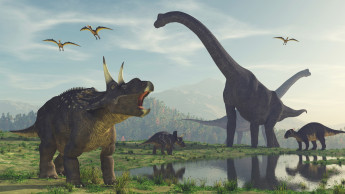dinosaur
Scientists unearth new dinosaur species in Argentina
Scientists have identified a new species of dinosaur in Argentina after unearthing remarkably complete fossils, including remains showing it may have feasted on an ancient crocodile relative.
The predator, named Joaquinraptor casali, measured around 23 feet (7 meters) in length and belonged to a little-understood group of dinosaurs known as megaraptorans. These carnivores once roamed across South America, Australia and parts of Asia, branching into different species over millions of years.
Megaraptorans are noted for their elongated skulls and “huge and very powerful claws,” said Lucio Ibiricu of the Patagonian Institute of Geology and Paleontology, who led the discovery. But their hunting behavior and place in the evolutionary chain remain unclear because of previously incomplete fossil records.
The newly discovered fossils — including parts of a skull, arms, legs and tail — were found in the Lago Colhué Huapi rock formation of Patagonia. Distinctive features in the remains confirmed to researchers that they had uncovered a new species.
“This fills a major gap by providing one of the most complete skeletons yet,” said Federico Agnolin of the Argentine Museum of Natural Science Bernardino Rivadavia, who was not involved in the study. The findings were published Tuesday in the journal Nature Communications.
Scientists estimate the dinosaur lived between 66 and 70 million years ago, close to the end of the Cretaceous period, and was at least 19 years old when it died. A front leg bone from an ancient crocodile relative, found pressed against its jaws, may provide insights into its diet and role as a possible top predator in the region’s lush prehistoric floodplains.
Ibiricu named the new species after his young son, Joaquin. “All children love dinosaurs, so he would probably be a fan too,” he said.
3 months ago
New two-clawed dinosaur species unearthed in Mongolia
Scientists have identified a rare dinosaur species with only two claws in Mongolia's Gobi Desert. Named Duonychus tsogtbaatari, this dinosaur belonged to the Therizinosaur group, which typically had three claws and walked on two legs.
Weighing around 260kg, the medium-sized dinosaur had distinctively long, curved claws. Researchers suggest these claws, coupled with strong flexing ability, helped it grasp vegetation efficiently.
Therizinosaurs, a group of plant-eating or omnivorous theropods, lived in Asia and North America during the Cretaceous Period, which lasted from 145 to 66 million years ago, reports BBC.
Among them, Therizinosaurus—recognised for its enormous claws—gained fame through its appearance in ‘Jurassic World Dominion’. Describing the group, Dr Darla Zelenitsky, a study co-author from the University of Calgary, noted their "awkward" appearance.
The newly discovered specimen was excavated from the Bayanshiree Formation, a Late Cretaceous fossil site in the Gobi Desert, dating back 100.5 to 66 million years.
Science, tradition combine to restore relics in Beijing
UNESCO acknowledges the Mongolian Gobi as one of the world's richest sites for dinosaur fossils, particularly from the Cretaceous period—the final chapter of the dinosaur era.
The study highlighted that Duonychus tsogtbaatari’s claws measured nearly a foot in length, significantly exceeding the size of the underlying bone. Besides grasping, these two-fingered hands might have been used for digging, display, or even as weapons.
Although two-fingered dinosaurs like Tyrannosaurus rex are well known, Duonychus developed this trait independently.
The specimen also preserved the first-ever recorded keratinous sheath of a therizinosaur, a structure similar to human fingernails, which may have aided in movement, defence, or capturing prey.
9 months ago
What is Colombia's "dinosaur of peace"?
A sauropod dinosaur was named a new species around 80 years after it was first discovered in a remote Colombian mountain range, thanks to the 2016 Peace Agreement, which put an end to half a century of civil war.
Around 175 million years ago, a 12-metre long sauropod walked northern Colombia.
Scientists are attributing the discovery of this new species of herbivorous dinosaur to the improved security situation in Colombia since the signing of the 2016 peace deal.
Two years after the signing of the agreement, a group of researchers from the Universidad del Norte, Barranquilla, and the University of Michigan, US, found it safe to visit the Serranía del Perijá, and gather new data.
The scientists returned to the place where a fossil of a dinosaur dorsal spine vertebra was found by a geologist working for an oil company in 1943. At the time no one knew that it was part of a brand-new species. After the find, the fossil was taken, along with some sediment samples, to the US and given to the University of California scientific collection at Berkeley.
"Without the security conditions provided in the area today, it would have been difficult to return to the field. This is due to the peace agreement," Aldo Rincón Burbano, professor at the Department of Physics and Geosciences at the Universidad del Norte in Barranquilla and one of the research leaders in Colombia, told UN News.
Former FARC-EP fighters provided logistical services, lodging, and guides for the researchers, as they tried to locate the site where the fossil had been unearthed some 80 years earlier.
Also read: Extinct dinosaur lectures world leaders about climate change
"We spent almost a year in the process, writing and searching, and although we didn't find any new fossils, we managed to get to the site and find the same sediment collected alongside the vertebra in 1943," said Rincón. "By studying the sediment, we were able to conclude that the vertebra was from a new genus and a new species."
They named the species Perijasaurus lapaz – the first part after the place where it was found and the second as a tribute to the peace agreement.
The dinosaur is similar to other sauropods of this period found in Asia, North Africa, and southern Patagonia, which were smaller than the later dinosaurs belonging to this group.
Also read: Footprints show some two-legged dinosaurs were agile
3 years ago
Weird ‘living fossil’ fish lives 100 years, pregnant for 5
The coelacanth — a giant weird fish still around from dinosaur times — can live for 100 years, a new study found.
These slow-moving, people-sized fish of the deep, nicknamed a “living fossil,” are the opposite of the live fast, die young mantra. These nocturnal fish grow at an achingly slow pace.
Females don’t hit sexual maturity until their late 50s, the study said, while male coelacanths are sexually mature at 40 to 69 years. And maybe strangest of all, researchers figure pregnancy in the fish lasts about five years.
Also read: Researchers discover fossils of new species in Arizona
Coelacanths, which have been around for 400 million years, were thought extinct until they were found alive in 1938 off South Africa. Scientists long believed coelacanths live about 20 years. But by applying a standard technique for dating commercial fish, French scientists calculated they actually live close to a century, according to a study in Thursday’s Current Biology.
Coelacanths are so endangered that scientists can only study specimens already caught and dead.
In the past, scientists calculated fish ages by counting big lines on a specific coelacanth scale. But the French scientists found they were missing smaller lines that could only be seen using polarized light — the technique used to figure out the age of commercial fish.
Study co-author Bruno Ernande, a marine evolutionary ecologist at France’s marine research institute, said polarized light revealed five smaller lines for every big one. The researchers concluded the smaller lines better correlated to a year of coelacanth age — and that indicated their oldest specimen was 84 years old.
Using the technique, the scientists studied two embryos and calculated the largest was five years old and the youngest was nine years old. So, Ernande said, they figured pregnancy lasts at least five years in coelacanths, which have live births.
Also read: Rare fishing cat captured in Chattogram village
That five-year gestation is “very strange” for fish or any animal, said Scripps Institution of Oceanography’s Harold Walker, who wasn’t part of the research.
Even though coelacanths are unrelated genetically and show wide evolutionary differences, they age slowly like other dwellers of the deep, sharks and rays, Ernande said. “They might have evolved similar life histories because they are sharing similar type habitats,” he said.
4 years ago
Study: 2.5 billion T. rex roamed Earth, but not all at once
One Tyrannosaurus rex seems scary enough. Now picture 2.5 billion of them. That’s how many of the fierce dinosaur king probably roamed Earth over the course of a couple million years, a new study finds.
Using calculations based on body size, sexual maturity and the creatures’ energy needs, a team at the University of California, Berkeley figured out just how many T. rex lived over 127,000 generations, according to a study in Thursday’s journal Science. It’s a first-of-its-kind number, but just an estimate with a margin of error that is the size of a T. rex.
Also read:Dinosaur-killing asteroid strike gave rise to Amazon rainforest
“That’s a lot of jaws,” said study lead author Charles Marshall, director of the University of California Museum of Paleontology. “That’s a lot of teeth. That’s a lot of claws.”
The species roamed North America for about 1.2 million to 3.6 million years, meaning the T. rex population density was small at any one moment. There would be about two in a place the size of the Washington, D.C., or 3,800 in California, the study said.
“Probably like a lot of people, I literally did a double-take to make sure that my eyes hadn’t deceived me when I first read that 2.5 billion T. rexes have ever lived,” said Macalester College paleobiologist Kristi Curry Rogers, who wasn’t part of the study.
Marshall said the estimate helps scientists figure the preservation rate of T. rex fossils and underscores how lucky the world is to know about them at all. About 100 or so T. rex fossils have been found — 32 of them with enough material to figure they are adults. If there were 2.5 million T. rex instead of 2.5 billion, we would probably have never known they existed, he said.
Marshall’s team calculated the population by using a general biology rule of thumb that says the bigger the animal, the less dense its population. Then they added estimates of how much energy the carnivorous T. rex needed to stay alive — somewhere between a Komodo dragon and a lion. The more energy required, the less dense the population. They also factored in that the T. rex reached sexual maturity somewhere around 14 to 17 years old and lived at most 28 years.
Also read:New dinosaur species "dancing dragon" identified in China
Given uncertainties in the creatures’ generation length, range and how long they roamed, the Berkeley team said the total population could be as little as 140 million or as much as 42 billion with 2.4 billion as the middle value.
4 years ago
100-mln-year-old dinosaur footprints found in east China
Beijing, Oct. 8 (Xinhua/UNB) -- Paleontologists announced Tuesday in Beijing they had discovered a group of 100-million-year-old fossils of dinosaur footprints in east China's Zhejiang Province.
6 years ago



.jpg)






